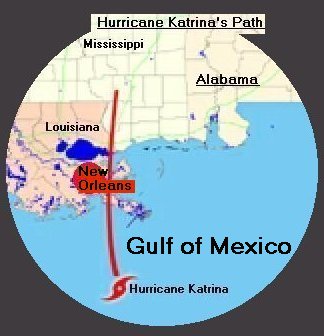The country's worst natural disaster. Katrina could become the costliest storm in America's history, exceeding the $100 billion.
Katrina is the 11th named storm of the Atlantic hurricane 2005 season but the first to hit U.S. shores in August.
New Orleans, the Nationís thirty-fifth largest city was destroyed. Towns and cities, small and large, were destroyed or heavily damaged up and down the Gulf Coast and miles inland. From Morgan City, Louisiana, to Biloxi, Mississippi, to Mobile, Alabama, Hurricane Katrinaís wind, rain, and storm surge demolished homes and businesses.TOP
Hurricane Katrina Louisiana Pictures!
   
   
   
   
TOP
Hurricane Katrina Mississippi Pictures!
   
   
   
TOP
West Virginia Air National Guard, Charleston, WV., Pictures - Hurricane Katrina!
   
TOP
Texas Pictures - Hurricane Katrina!
   
Tropical Storm Katrina formed Wednesday morning (August 24,2005), in the Bahamas and moved toward Bahamas Island knocking out power in some areas of the Bahamas Island and shuting down the Bahmas Island Airports.
August 25, 2005, Thursday evening, Katrina's center was located just a few miles east-northeast of Fort Lauderdale Flordia and was moving west with sustained winds 75 miles per hour with higher gusts. Katrina ranked at the bottom of the hurricane intensity scale at this time. ( Saffir-Simpson scale).
Katrina carried top sustained winds of 80 mph when its eye came ashore between Miami and Fort Lauderdale and early Friday (August 26,2005), Katrina had weakened into a tropical storm with top sustained winds of 70 mph at this point four people were dead.
Work its way across the Gulf of Mexico, making a northern turn and and moved toward Mississippi and Louisiana and intensified Sunday (August 28,2005) to a Category 5 storm. The last time Mississippi and Louisiana was hit by a major hurricane was in 1969 (Hurricane Camille strikes Mississippi coast as only the second category five hurricane recorded in US history. She leaves 260 dead in her wake).
Many left New Orleans Sunday (August 28,2005) in the early part of the day and by midday Sunday Highways in Mississippi and Louisiana were jammed as people headed away and many people went to the New Orleans Superdome.
Hurricane Katrina makes landfall for the second time August 29, 2005 09:31 as a category 4 hurricane and overwhelm Louisiana, Mississippi and Alabama. Katrina weakened as it moved inland to the north-northeast but was still a strong hurricane.
"It's too dangerous to come home," Gov. Kathleen Blanco said at a news conference in Baton Rouge.
On Tuesday, August 30, 2005, the storm was situated over the Tennessee valley. At this time Katrina was weakening and no longer classified as a hurricane, and would soon become an extratropical depression. In Louisiana and Mississipppi rescue personnal check for stranded victims and medical disaster assistance teams from acrooss the country were deployed. Federal officials urging those who want to help to donate money.
"We are dealing with one of the worst natural disasters in our nation's history. This recovery will take years," President Bush said Wednesday (August 31,2005) after flying over the devastated region.
President efforts are now focused on three priorities:- Our first priority is to save lives. We're assisting local officials in New Orleans in evacuating any remaining citizens from the affected area. I want to thank the state of Texas, and particularly Harris County and the city of Houston and officials with the Houston Astrodome, for providing shelter to those citizens who found refuge in the Super Dome in Louisiana. Buses are on the way to take those people from New Orleans to Houston.
- Our second priority is to sustain lives by ensuring adequate food, water, shelter and medical supplies for survivors and dedicated citizens -- dislocated citizens.
- Our third priority is executing a comprehensive recovery effort. We're focusing on restoring power and lines of communication that have been knocked out during the storm. We'll be repairing major roads and bridges and other essential means of transportation as quickly as possible.
Superdome evacuation begins Thursday, September 01, 2005 to the Houston Astrodome and buses started showing up around 3 a.m.
Saturday, September 03, 2005. The Last of thousands of evacuees from the Superdome and convention center en route to shelters in Houston and other cities.
(Monday September 05,2005) One week later after Hurricane Katrina makes landfall. Louisiana officials urged the hundreds of thousands of people in the state who fled Hurricane Katrina to stay put.
New Orleans police forcus their attention on the people who refuse to leave in the aftermath of Hurricane Katrina. Mayor C. Ray Nagin ordered law officers and the military late Tuesday (09/06/2005) to evacuate all holdouts and force will be used if necessary. He warned that the risk of disease and fire make New Orleans too dangerous of a city for the holdouts. Armed police walk door to door and plead with refugees to evacuate New Orleans, but many survivors are refusing to leave their homes.
The latest EPA tests confirmed Wednesday ( August 07,2005 ) that the amount of sewage-related bacteria in the floodwaters is at least 10 times higher than acceptable safety levels
September 8, 1900 A devastating hurricane strikes Galveston resulting in over 8000 deaths (or perhaps as many as 12,000). Now September 8, 2005, 105 years later and thousands feared dead in New Orleans and in Mississippi and bodies are starting to pile up. This could be the the nation's deadliest hurricane.
Facts- Whom to blame, every level of government, federal, state and local levels was not well-coordinated, and was overwhelmed in the first few days.
- The entire population of New Orleans, around 484674 people were displaced as a result of Hurricane Katrina and the breaks in the levees which flooded most of the city.
- Price of regular unleaded gasoline climbed about 40 percent higher the last few days of August 2005, to $3.07 per gallon by September 6, 2005, 34 percent above the July 2005 nationwide average.
- Hurricane Katrina could result between 0.5 percentage and a full percentage point reduction in U.S. economic growth and cost up to 400,000 jobs, the Congressional Budget Office ( CBO ) said in an analysis.
- FEMA passed out about 4,200 emergency debit cards worth up to $2,000 to evacuees inside Houston's Astrodome Friday September 09,2005. President Approves $52 Billion more in aid to Gulf Coast.
- As of September 10: 2005 Nearly $690 million in federal aid has been distributed. More than 330,000 households today have a $2,000 FEMA grant either already in hand or have one on the way. Families temporarily residing in all 50 states and the District of Columbia are receiving assistance.
- Sept-15-2005 - The repairs from Hurricane Katrina will be one of the largest rebuilding efforts the world has ever seen with etimates ranging up to $200 billion for rebuilding New Orleans and other Gulf Coast Cities.
- September 16, 2005. Fewer bodies found than expected so far, Louisiana have 558 Katrina deaths for a five-state total of 794.
- As of February 2006 an estimated 1,330 people were dead as a result of the storm. The vast majority of the fatalities an estimated 80 percent came from the New Orleans metropolitan area (an estimated population about 1,293,843) and Mississippi suffered greatly as well, with 231 fatalities. Many of the dead were elderly. In Louisiana, approximately 71 percent of the victims were older than sixty, and 47 percent of those were over seventy-five. At least sixty-eight were found in nursing homes, some of whom were allegedly abandoned by their caretakers. Of the total known fatalities, there are almost two hundred unclaimed bodies remaining at the Victim Identification Center in Carville, Louisiana. As awful as these horrifying statistics are, unfortunately they are not the end of the story.
- As of February 17, 2006, there were still 2,096 people from the Gulf Coast area reported missing.
- For the survivors, the aftermath of Hurricane Katrina has been characterized by a mixture of grief, anxiety, and frustration. Around 770,000 people were displaced.
- Hurricane Katrina devastated far more residential property than had any other recent hurricane, completely destroying or making uninhabitable an estimated 300,000 homes.
- The storm destroyed so many homes, buildings, forests, and green spaces that an extraordinary amount of debris was left behind 118 million cubic yards.
- Fact: New Orleans will have Mardi Gras in 2006 after enduring the wrath of Hurricane Katrina!
Parades will be packed into an 11-day schedule from February 18 to 28 and Fat Tuesday, February 28, 2006


|







































